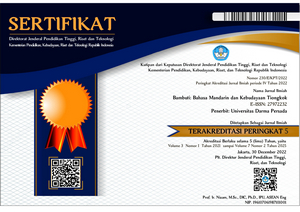SHÌ (是) DALAM BAHASA CINA MODERN (现代汉语) DAN KLASIK (古代汉语)
SHÌ (是) IN MODERN CHINESE (现代 汉语) AND CLASSIC (古代 汉语)
Abstract
Abstract. This article describes the use of the word 是(shi) in Modern Chinese Language (Mandarin/MCL) and Classical Chinese Language (CCL), and compares them so that can understand the similarities and differences of the word, both the structure (includes the class of words) and their meaning. This study describes the symptoms of language especially in syntactic and semantic, using comparative analysis methods. The results of analysis indicates that generally the word 是(shi) in MCL is verb, functions as a predicate, and becomes a connecting verb (copula) between the subject and its object, or connects nouns, pronouns, other phrases, and expresses many meanings. Conversely, the use of 是(shi) in CCL is very rare, and generally not as verbs or copula, but as pronouns and conjuctions.

This work is licensed under a Lisensi Creative Commons Atribusi 4.0 Internasional.
Authors who publish with this journal agree to the following terms:
- Authors retain copyright and grant the journal right of first publication with the work simultaneously licensed under a Lisensi Creative Commons Atribusi 4.0 Internasional that allows others to share the work with an acknowledgment of the work's authorship and initial publication in this journal.
- Authors are able to enter into separate, additional contractual arrangements for the non-exclusive distribution of the journal's published version of the work (e.g., post it to an institutional repository or publish it in a book), with an acknowledgment of its initial publication in this journal.
- Authors are permitted and encouraged to post their work online (e.g., in institutional repositories or on their website) prior to and during the submission process, as it can lead to productive exchanges, as well as earlier and greater citation of published work (See The Effect of Open Access).









